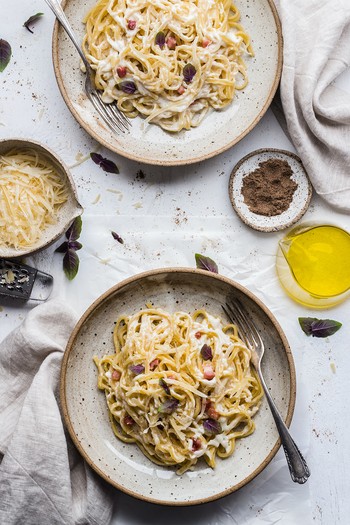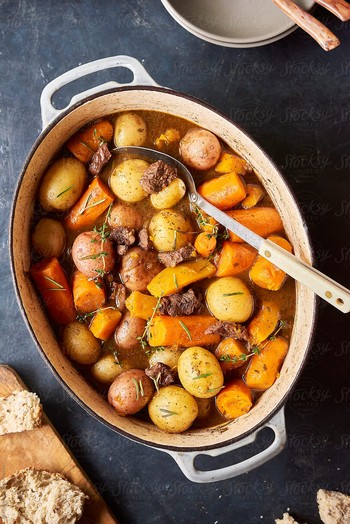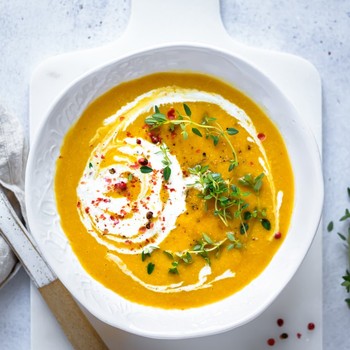How To Eat Healthy On A Budget
All products on this page have been selected by our editorial team, however we may make commission on some products.
Eat Seasonally
Seasonal food is fresher, tastier and more nutritious than food that’s consumed out of season. It’s also more affordable, says Caroline Hind, registered nutritional therapist for Vitaminology. “Seasonal and local vegetables are wallet and body-friendly. Get into the habit of looking at labels in the supermarket and only buying fruit and vegetables that are produced in the UK. Also, don’t be lured by exotic and trendy vegetables – for example, spring greens usually cost less than £1 a pack and have a much sweeter flavour than kale or spinach. If you have the space, consider growing your own herbs too. Basil and parsley can pep up plain iceberg lettuce, which is a more affordable option compared to bags of pre-prepared mixed salad.”
Don’t Discount Tinned Food
Tinned fish, beans and vegetables may not be the most obvious source of nutrition, but they’re a great, affordable way to incorporate valuable nutrients into your diet. “Canned foods can be just as healthy as their fresh counterparts,” Caroline continues. “Tinned tomatoes, for example, add flavour and bulk to meals. Plus, the chopping and blending of tomatoes actually increases the availability of lycopene, an antioxidant that helps protect the body’s cells from damage. Tinned fish is also a no-brainer, especially mackerel and sardines. They are rich in omega-3 fats, which are essential for the brain and nervous system and have an anti-inflammatory effect. Try using tinned fish to make homemade fishcakes.” Stock up on a variety of tinned foods, but be wary of tinned fruit, adds Reema Patel, registered dietitian and nutritionist for Dietitian Fit & Co. “Tinned fruit is often stored in syrup, which is pure sugar. Similarly, be careful of tinned food stored in brine, which is high in salt. If you are trying to cut back on salt, try rinsing tinned produce well before consuming.”
Dust Off Your Slow Cooker
More affordable cuts of meat may take a little more time to cook, but are a fantastic way to save money. For example, braising steak, brisket or shoulder can be slow-cooked to break down the fibres in cheaper cuts and make them more tender. “A slow-cooked stew with the chunk or flank meat, combined with celery, carrots and mushrooms, served with new potatoes, is a simple way to eat well,” says Reema. “At the same time, buying a whole chicken may seem more expensive initially, but it actually provides a variety of meals, and you can also use the bones to make stocks and sauces. Roast a whole chicken and use the leftovers in pies, stir fries and omelettes.”
Know You’re Not Limited To Rice & Pasta
Pesto pasta and risotto may be the types of dishes we associate with budget-friendly cooking, but lower-carb options are possible, says nutritionist Sophie Trotman. “Eggs are extremely nutritious, high in protein and low in carbs,” she tells us. “Plus, eggs are versatile – think omelettes and frittatas, or even just a fried egg over a dish. Yoghurt is also a fantastic and affordable source of protein – pair it with frozen berries and a low-sugar supermarket own brand granola for breakfast. If you are trying to cut back on carbs, also make use of lots of non-starchy vegetables, like cauliflower and broccoli, to increase the fibre of your food in an affordable way.” And if you’re craving carbs, try potatoes, not pasta or rice, which, according to Caroline, are more nutrient-dense. “Potatoes are rich in nutrients and one of the most affordable vegetables you can buy,” she says.

BRUNA BRANCO/UNSPLASH
Shop In The Frozen Section
“Many frozen fruits and vegetables are frozen almost immediately after harvesting, so this means they are likely to retain the majority of their nutrients,” says Reema. “Frozen fruit and veg may even contain more nutrition than their fresh counterparts, which could be a week old before arriving at the supermarket.” Reema is a fan of frozen berries which she adds to porridge, yoghurt bowls and smoothies, while frozen spinach is significantly more affordable than fresh and can be added to everything from smoothies to soups and pasta dishes to boost the nutrient content. “Frozen fish can also be incredibly good value,” she says. “A fish curry lends itself well to frozen fish, as the fish can gently cook in a curry sauce until beautifully flaky.”
Chat To Local Suppliers
In an age of online food shopping, many of us have fallen out of touch with where our food comes from, but local farmers, butchers and fishmongers can help if you are on a budget. “Ask your butcher about cheaper off-cuts, and consider buying minced beef with a higher fat content, as it’s usually cheaper than lean mince. Don’t worry too much about the fat content in this instance – this is whole-food, naturally-occurring fat, plus, full-fat mince is far more delicious and filling,” adds Caroline. “Also, ask your butcher about turkey, which tends to be more affordable than chicken. Minced turkey has a mild flavour that can be mixed with flavourings such as soy sauce and onion to make burgers or meatballs. Avoid frozen chicken that contains additives – these packs also tend to contain sugar, chemicals and a lot of water,” Caroline says.
Make Your Own Takeaway
If you’re looking to save a few pennies, start by deleting Uber Eats and Deliveroo from your phone, says Sophie. “These companies have armies of web developers whose job is to get you to use your app more. For example, if you tend to order food on a Wednesday evening at 8pm, at 7pm they’re likely to send you an offer for your favourite item. Consider deleting the apps and redownload when you really want to order something.” Sophie recommends getting into the habit of making your own curries and favourite delivery foods – such as Thai green curry – in bulk and freezing individual portions. “Making your own dips is also affordable and delicious. Hummus can easily be made with chickpeas, garlic, extra virgin olive oil, tahini and salt. Add harissa or paprika to switch up the flavours,” she says.
Get Creative
“It’s absolutely possible to eat well on a budget,” stresses Reema. “For example, breakfast could be a bowl of porridge made using own-brand supermarket oats, topped with frozen berries (always more affordable than fresh) and a spoon of plain yoghurt. If you fancy something savoury, make an omelette with two or three eggs and add frozen spinach and onions and dried herbs. Lunch, meanwhile, could be a salad made with lettuce, cherry tomatoes and cucumber and tinned mackerel. In the winter, also consider making soup using a variety of root vegetables – potato, carrots and parsnips. Add in dried lentils for extra protein and to keep you fuller for longer. For dinner, try a slow-cooked veggie chilli with kidney beans, carrots, sweet potato and peppers, using tinned tomatoes and a range of dried herbs and spices. The vegetables can be frozen, to make this dish even more budget friendly, and you can use dried beans instead of tinned.”

Save On Sweet Treats
Instead of pre-packaged treats, consider making your own. “Banana bread is a budget-friendly staple,” she says. “If you use very ripe bananas, there’s no need to add additional sugar, and you can swap out butter for vegetable oil to further reduce the cost. Experiment with adding spices such as cinnamon and nutmeg for extra flavour. Also try making yoghurt bark – spread Greek yoghurt (a supermarket own-brand works well) across a baking tray lined with clingfilm and sprinkle over frozen berries and pumpkin seeds. Top with a drizzle of honey or a handful of chocolate chips for extra sweetness. Freeze until firm, break apart and enjoy when you want something sweet.”
Always Have A Plan
Taking time at the weekend to work out a meal plan for the upcoming week is a must if you’re looking to shop sensibly, says Reema. “Having a rough idea of the meals you’d like to cook in the week will not only help you stick to a budget, but will ensure less waste in the long-term, too. Always create a shopping list, which will help you avoid buying food you may not use, and if you’re often tempted by unnecessary items, try shopping online. Don’t be lured by big brand names, either, and get into the habit of reading the ingredients list. Supermarket own brands and classic, well-known brands often use exactly the same ingredients and stack up identically nutritionally.”
For more information visit Vitaminology.co, DietitianFit.co.uk & SophieTrotmanNutrition.com
DISCLAIMER: Features published by SheerLuxe are not intended to treat, diagnose, cure or prevent any disease. Always seek the advice of your GP or another qualified healthcare provider for any questions you have regarding a medical condition, and before undertaking any diet, exercise or other health-related programme.
DISCLAIMER: We endeavour to always credit the correct original source of every image we use. If you think a credit may be incorrect, please contact us at info@sheerluxe.com.
